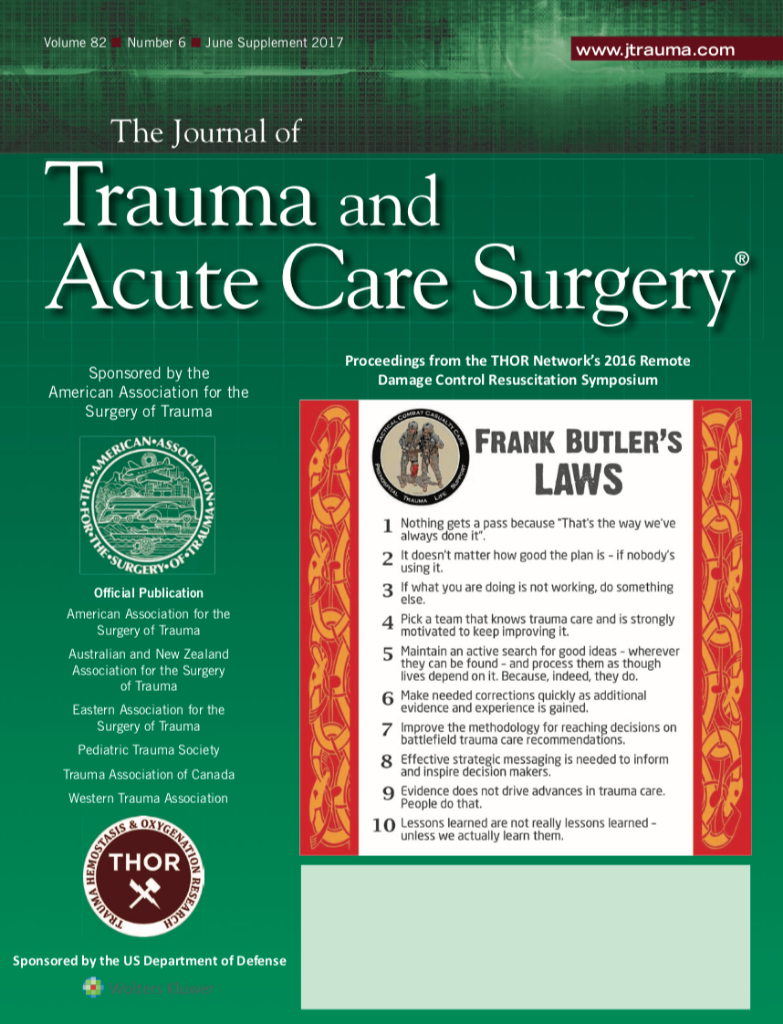
Pilot Study - Fluid lavage of open wounds: The need for RCT of irrigation approaches

Pilot Study - Fluid lavage of open wounds: The need for RCT of irrigation approaches
Fluid Lavage of Open Wounds (FLOW): A Multicenter, Blinded,Factorial Pilot Trial Comparing Alternative Irrigating Solutions and Pressures in Patients With Open Fractures
J Trauma. 2011 Sep;71(3):596-606.Did you know you're eligible to earn 0.5 CME credits for reading this report? Click Here
OE EXCLUSIVE
Dr. Brad Petrisor discusses a pilot study examining the fluid lavage of open wounds
Synopsis
111 patients at different centers across the world with open fracture wound were randomized to be treated with either castile soap solution or normal saline and either high- or low-pressure pulsatile lavage. The primary composite outcome of reoperation, measured at 12 months after initial operative procedure, included infection, wound healing problems, and nonunion. Secondary outcomes included the functional outcomes scores. No statistically significant difference was found between treatments because of the low adverse event rate, but data suggests that the low pressure lavage may be beneficial in decreasing the infection risk, this yet remains to be proven in a bigger RCT.
Was the allocation sequence adequately generated?
Was allocation adequately concealed?
Blinding Treatment Providers: Was knowledge of the allocated interventions adequately prevented?
Blinding Outcome Assessors: Was knowledge of the allocated interventions adequately prevented?
Blinding Patients: Was knowledge of the allocated interventions adequately prevented?
Was loss to follow-up (missing outcome data) infrequent?
Are reports of the study free of suggestion of selective outcome reporting?
Were outcomes objective, patient-important and assessed in a manner to limit bias (ie. duplicate assessors, Independent assessors)?
Was the sample size sufficiently large to assure a balance of prognosis and sufficiently large number of outcome events?
Was investigator expertise/experience with both treatment and control techniques likely the same (ie.were criteria for surgeon participation/expertise provided)?
Yes = 1
Uncertain = 0.5
Not Relevant = 0
No = 0
The Reporting Criteria Assessment evaluates the transparency with which authors report the methodological and trial characteristics of the trial within the publication. The assessment is divided into five categories which are presented below.
4/4
Randomization
4/4
Outcome Measurements
4/4
Inclusion / Exclusion
4/4
Therapy Description
4/4
Statistics
Detsky AS, Naylor CD, O'Rourke K, McGeer AJ, L'Abbé KA. J Clin Epidemiol. 1992;45:255-65
The Fragility Index is a tool that aids in the interpretation of significant findings, providing a measure of strength for a result. The Fragility Index represents the number of consecutive events that need to be added to a dichotomous outcome to make the finding no longer significant. A small number represents a weaker finding and a large number represents a stronger finding.
Why was this study needed now?
Open fractures can be challenging to treat because of associated morbidity resulting from delayed union, nonunion, and infection. A thorough wash out and debridement are the gold standard treatments for preventing infection. There have been smaller studies suggesting different lavage fluids and disinfectants for irrigation to be better than saline. Also several products in market are available with variable pressures for lavage. However, there is still a dearth of randomized trials comparing commonly used irrigating solutions or even irrigating technique. This study compared the use of castile soap versus normal saline and high- versus low-pressure pulsatile lavage on the rates of reoperations and complications in patients with open fracture wounds.
What was the principal research question?
Does the irrigation fluid and the pressure, at which it is run on an open fracture wash out, lead to differences in infection rates and rates of re-operation(s)?
What were the important findings?
- 23% of patients in the castile soap group and 24% of patients in the saline group had a primary outcome event (hazard ratio, 0.91, 95% confidence interval: 0.4-2.00, p= 0.52).
- 28% of patients in the high-pressure group and 19% of patients in the low-pressure group had a primary outcome event (hazard ratio 0.55, 95% confidence interval: 0.24-1.27, p= 0.17).
- Functional outcome scores showed no significant differences at any time point between groups.
What should I remember most?
There is a possibility that the use of low pressure may decrease the reoperation rate for infection, wound healing problems, or nonunion.
How will this affect the care of my patients?
There is a good possibility that the use of low pressure may decrease the re-operation rate for infection, wound healing problems, or nonunion; however, a larger study is required to ascertain this precisely.
Learn about our AI Driven
High Impact Search Feature
Our AI driven High Impact metric calculates the impact an article will have by considering both the publishing journal and the content of the article itself. Built using the latest advances in natural language processing, OE High Impact predicts an article’s future number of citations better than impact factor alone.
Continue



 LOGIN
LOGIN

Join the Conversation
Please Login or Join to leave comments.